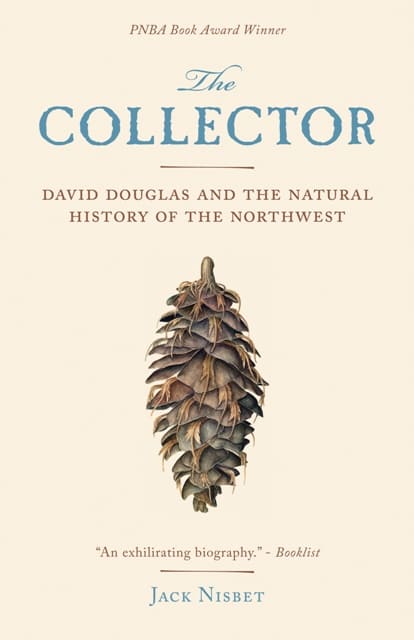David Douglas: Collector, Naturalist, Explorer
 While spring is busy blooming and blossoming at the North Cascades Environmental Learning Center, there is still time during quiet evenings to curl up and read a good book. For those of you interested in expanding your understanding of the early days of natural history exploration in the Northwest region, The Collector by Washingtonian writer, teacher, and naturalist Jack Nisbet is the perfect read for you.
While spring is busy blooming and blossoming at the North Cascades Environmental Learning Center, there is still time during quiet evenings to curl up and read a good book. For those of you interested in expanding your understanding of the early days of natural history exploration in the Northwest region, The Collector by Washingtonian writer, teacher, and naturalist Jack Nisbet is the perfect read for you.
The Collector recounts in wonderful detail the life and influence of Scottish naturalist David Douglas and his forays throughout the Pacific Northwest in the name of science and the London Horticultural Society. Between 1824 and 1834, Douglas traveled by foot, canoe, and horseback, exploring the uncharted and vast landscapes of the Pacific Northwest. Along the way he gathered, identified, and catalogued everything from mineral and bird to wolverine and desert lomatium. Douglas also built relationships with countless fur traders and native tribes, and Nisbet explores excerpts from his journals that candidly portray both the erosion of indigenous culture and the beginnings of conflict in the New World as a result of early European settlement.
While David Douglas’ time in the region may have been short, his legacy was certainly not. Douglas explored over 7,032 miles of terrain on his first journey to the Pacific Northwest Coast alone, returning to the New World a second time in search of even greater botanical and zoological findings. Although dying an untimely and brutal death in Hawaii in 1834, his findings proved to have an invaluable impact on silviculture (he identified and brought to England the sugar pine from the Umpqua mountains, an important timber producing species in England), on horticulture (he introduced some of the most sought after cultivars to European gardens), on cartography (his map surveying helped define many geographical and state boundaries throughout the Northwest region), and on the larger body of scientific knowledge emerging at the time. Indeed, the douglasii name is attached to over 80 species of flora and fauna today. All we have to do at the Environmental Learning Center to appreciate the influence of this man is to take a quick walk through the woods and look up at a Douglas fir tree, or glance down and find a scattering of its easily distinguishable cones.
 A handful of middens – the torn apart central stalks and scales of Douglas fir cones – is evidence of a hungry Douglas squirrel searching for food. Photo by Kai Girard.
A handful of middens – the torn apart central stalks and scales of Douglas fir cones – is evidence of a hungry Douglas squirrel searching for food. Photo by Kai Girard.
Jack Nisbet does a wonderful job of illustrating David Douglas as a man of great ambition and passion. Douglas was relentless in his desire to claim the land for botany, and to that end he worked incessantly to explore every untouched corner of the region and document his findings. As a Pacific Northwesterner myself, I delighted in imagining Douglas’ adventures through these landscapes – the flanks of Mount St. Helens a century and a half before she blew, the green valleys of the Umpqua, the steep basalt walls of the Columbia River, the rocky shores of the Oregon Coast, the vast mountains of the Cascades. Douglas explored and described the beauty of these places and, like me, had arresting and transforming experiences in them. Although admittedly not much of a writer himself, he kept a detailed field journal to record the flora and fauna that he found on his journeys – the same naturalist’s instruments that remain universal today for any who wish to discover the world through careful observation, patience, and a pen. There is something comforting in knowing that as I walk the valleys, mountains, and shorelines of the Pacific Northwest with my notebook and pen, I am in some sense engaging in, and preserving, a timeless activity that continues to call attention back to the land.
I greatly enjoyed this book for its wonderful portrayal of the Pacific Northwest landscape at a time when it was vast and boundless and still largely unmarred by human industry. I also loved envisioning the journey of an early naturalist through places in my native homeland that I travel to today, and that I now know were shaped by his work and discoveries. In his short career, David Douglas proved to be hugely influential to our modern understanding of the natural history of the Pacific Northwest and, after reading of his life, I feel my own understanding of this rich landscape has also been deepened.
The Collector is a winner of the 2010 PNBA Book Award, celebrating excellence in writing from the Pacific Northwest.


Wonderful review. I felt as if I were reading a review by someone writing for the New Yorker!
You captured the essence of his book and the essence of Douglas. Quite an accomplishment in just a few paragraphs.
“There is something comforting in knowing that as I walk the valleys, mountains, and shorelines of the Pacific Northwest with my notebook and pen, I am in some sense engaging in, and preserving, a timeless activity that continues to call attention back to the land.” — very nicely said, and a wonderful way to envision our naturalizing wanderings!